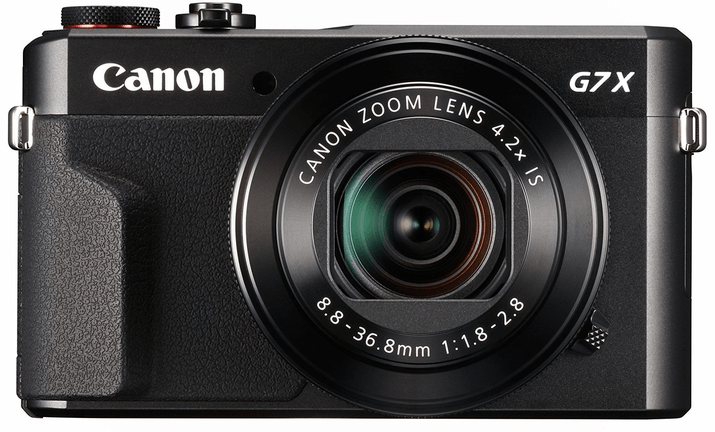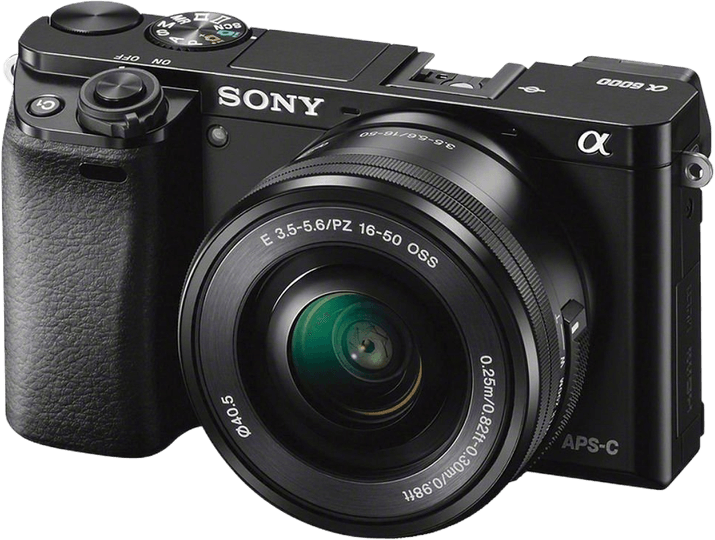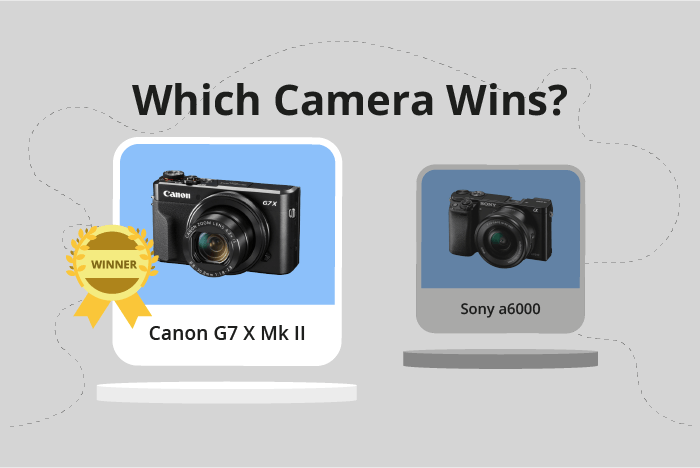Canon PowerShot G7 X Mark II vs Sony a6000 Comparison
Canon PowerShot G7 X Mark II

Sony a6000

The Canon PowerShot G7 X Mark II edges out the Sony a6000 with a score of 59/100 compared to 57/100. Both cameras share similarities, such as their announcement years of 2016 and 2014, respectively, as well as their launch prices of $699 and $799. They also have comparable sizes and weights, with the Canon being slightly smaller and lighter at 106 x 61 x 42mm and 319g, while the Sony measures 120 x 67 x 45mm and weighs 344g.
The Canon’s higher score is attributed to its compact design, making it more portable and user-friendly. However, the Sony a6000, being a mirrorless camera, offers a more advanced and versatile shooting experience. Despite the close scores, each camera caters to different preferences and needs, with the Canon PowerShot G7 X Mark II being ideal for casual photographers and the Sony a6000 better suited for more experienced users.
Canon PowerShot G7 X Mark II vs Sony a6000 Overview and Optics
The Sony a6000 outperforms the Canon PowerShot G7 X Mark II in optics, with a score of 67/100 compared to the Canon’s 58/100. Both cameras share some common specifications, such as a CMOS sensor, lack of image stabilization, and similar processors – the Canon with a Digic 7 and the Sony with a Bionz X.
The Sony a6000 has a higher megapixel count at 24.3 compared to the Canon’s 20, which allows for greater image resolution. Additionally, the Sony a6000 has a faster shooting speed of 11 frames per second, compared to the Canon’s 8. This makes the Sony a6000 more suitable for capturing fast-moving subjects. Furthermore, the Sony a6000 has a higher DXOMARK sensor score of 82, compared to the Canon’s 79. The Sony a6000 also has a larger sensor size (APS-C) and a Sony E lens mount, allowing for interchangeable lenses.
On the other hand, the Canon PowerShot G7 X Mark II has a fixed lens mount, which means that the lens cannot be changed. This can be an advantage for users who prefer simplicity and do not want to invest in additional lenses. However, this limits the camera’s versatility and adaptability for different shooting scenarios.
In comparing the optics of these two cameras, the Sony a6000 offers superior image quality, resolution, and shooting speed. Its interchangeable lens system provides more flexibility for various photography needs. The Canon PowerShot G7 X Mark II may be more suitable for users who prefer a simpler, fixed-lens camera. However, its optic performance falls short in comparison to the Sony a6000.
Canon PowerShot G7 X Mark II vs Sony a6000 Video Performance
The Canon PowerShot G7 X Mark II outperforms the Sony a6000 in video capabilities, scoring 70 out of 100, compared to the Sony a6000’s score of 56. Both cameras share some common specifications, such as Full HD video resolution and max video dimensions of 1920 x 1080. Additionally, they both offer a max video frame rate of 60fps, ensuring smooth footage.
The Canon PowerShot G7 X Mark II’s superior score stems from its built-in time-lapse functionality. This feature allows users to create stunning time-lapse videos effortlessly, without the need for additional software or equipment. This advantage makes the Canon PowerShot G7 X Mark II a more versatile option for those interested in capturing dynamic video content.
On the other hand, the Sony a6000 doesn’t offer any distinct advantages in terms of video capabilities over the Canon PowerShot G7 X Mark II. Both cameras have the same video resolution, dimensions, and frame rate, but the Sony a6000 lacks the built-in time-lapse functionality present in the Canon model.
Therefore, the Canon PowerShot G7 X Mark II is the superior choice for users seeking advanced video capabilities. Its built-in time-lapse functionality sets it apart from the Sony a6000, which doesn’t offer any unique advantages in this area. With its higher video score and additional features, the Canon PowerShot G7 X Mark II is the clear winner in this comparison.
Canon PowerShot G7 X Mark II vs Sony a6000 Features and Benefits
The Canon PowerShot G7 X Mark II outperforms the Sony a6000 in terms of features, scoring 70 out of 100 compared to the Sony’s 41. Both cameras share several specifications, including a 3-inch screen size, flip screen, lack of GPS, and WIFI capabilities.
The G7 X Mark II proves to be superior with its screen resolution of 1,040,000 dots, compared to the a6000’s 921,600 dots. This results in a sharper and clearer display for the Canon model. Additionally, the G7 X Mark II has a touchscreen, making it more user-friendly and easier to navigate. The Canon camera also offers Bluetooth connectivity, allowing for effortless pairing with compatible devices and remote control options.
On the other hand, the Sony a6000 does not provide a touchscreen or Bluetooth features, which could be seen as limitations. However, it still offers a flip screen and WIFI capabilities, making it a suitable option for those who prioritize these particular features.
In terms of features, the Canon PowerShot G7 X Mark II is the clear winner due to its higher screen resolution, touchscreen, and Bluetooth connectivity. These features contribute to a more seamless and enjoyable user experience. The Sony a6000 may be a suitable choice for those who are not concerned with the additional benefits provided by the G7 X Mark II, but it is undeniable that the Canon model offers a more comprehensive set of features.
Canon PowerShot G7 X Mark II vs Sony a6000 Storage and Battery
The Canon PowerShot G7 X Mark II outperforms the Sony a6000 in storage and battery, scoring 29/100 compared to the Sony’s 21/100. Both cameras share similarities in storage, with one memory card slot each and compatibility with SD, SDHC, and SDXC cards. However, the Canon G7 X Mark II also supports UHS-I cards, offering faster data transfer rates.
In terms of battery life, the Sony a6000 holds an advantage with 360 shots per charge, whereas the Canon G7 X Mark II provides 265 shots. Despite this, the Canon camera benefits from USB charging, a feature absent in the Sony a6000. This allows for more convenient charging options when on-the-go.
Considering these factors, the Canon PowerShot G7 X Mark II proves to be the better choice in storage and battery performance, with its UHS-I compatibility and USB charging capabilities. The Sony a6000, however, may still appeal to those who prioritize longer battery life.
Canon PowerShot G7 X Mark II vs Sony a6000 – Our Verdict
Are you still undecided about which camera is right for you? Have a look at these popular comparisons that feature the Canon PowerShot G7 X Mark II or the Sony a6000:

